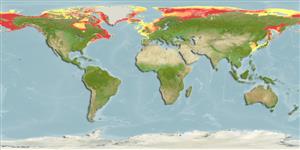Common names from other countries
Environment: milieu / climate zone / depth range / distribution range
Ecologie
Bathydemersaal. Temperate; 90°N - 0°S, 180°W - 180°E
Pacific Northwest, Pacific Ocean, Atlantic Ocean and the Arctic: Bering Sea, Sea of Okhotsk, Atlantic Ocean, Canada Quebec, Alaska, Greenland, Canada Newfoundland, Norway, Russia, Japan (Ref. 1394), Canada, Iceland, UK, France, Spain, Portugal, China, Kamchatka, Laptev Sea (Ref. 1522); Erignathus barbatus barbatus: Canada, Greenland, Russia, Canada Newfoundland, Iceland, Norway, UK, France, Spain, Portugal; Erignathus barbatus nauticus: Russia, Canada, Laptev Sea, Alaska, Japan, China, Sea of Okhotsk, Kamchatka.
Length at first maturity / Size / Gewicht / Leeftijd
Maturity: Lm ? range ? - ? cm Max length : 250 cm TL mannelijk/geslacht niet bekend; (Ref. 1394)
They usually restrict themselves to sea ice and stay in relatively shallow areas of continuously moving ice, where open leads and polynyas regularly form. In some areas, they are known to haul out on shore, ascend streams, or live a pelagic existence away from ice and land for long periods of time. Feeds on many species of small invertebrates that live on, and in, the bottom; and fish (Ref. 1394). They usually restrict themselves to sea ice and stay in relatively shallow areas of continuously moving ice, where open leads and polynyas regularly form. In some areas, they are known to haul out on shore, ascend streams, or live a pelagic existence away from ice and land for long periods of time. Feeds on many species of small invertebrates that live on, and in, the bottom; fish (Ref. 1394).
Jefferson, T.A., S. Leatherwood and M.A. Webber. 1993. (Ref. 1394)
Status op de Rode Lijst van het IUCN (Ref. 130435)
Status bij CITES (Ref. 108899)
Not Evaluated
Not Evaluated
Gebruik door de mens
Visserij: commercieel
FAO - Visserij: landings, soortsprofiel | FishSource | Sea Around Us
Tools
Internet-bronnen
Estimates based on models
Preferred temperature
(Ref.
115969): -1.7 - 8.9, mean 0.5 (based on 6792 cells).
Weerstandsvermogen
Gemiddeld, minimale populatieverdubbelingstijd 1,4-4,4 jaar (K=0.18-0.29).
Kwetsbaarheid
Moderate to high vulnerability (55 of 100).
Prijsklasse
Unknown.
